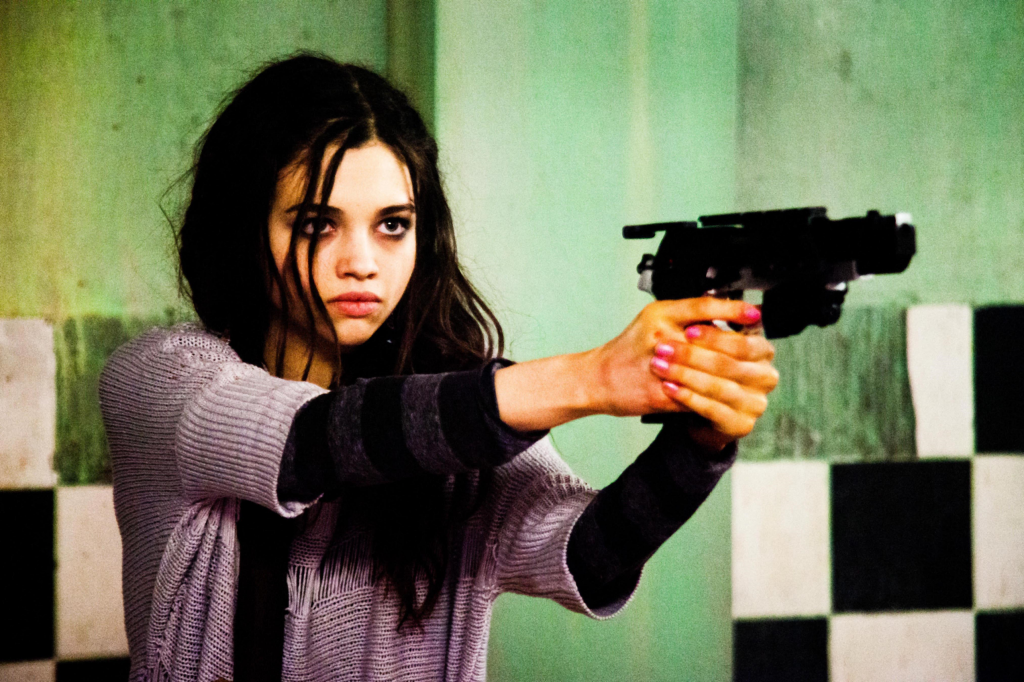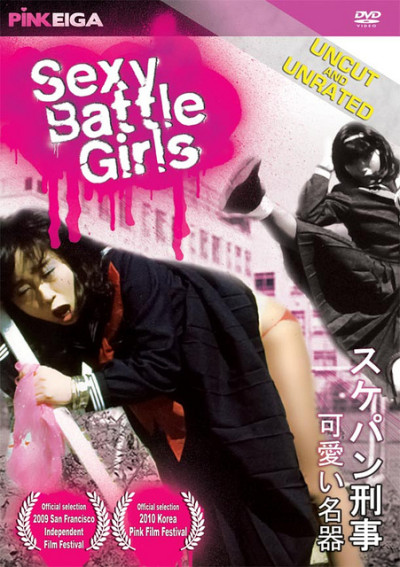★★
“A two-dimensional adaptation of two-dimensional animation”
 Loosely based on the notorious anime, this relocates things to South Africa, after a financial crash has turned everything into a giant slum, and human trafficking gangs operate with impunity. Sawa (Eisley) is on a mission, searching for the Emir, the leaders of one such network, whom she blames for the death of both her mother and policeman father. She’s helped, as she works her way up the chain of command, by her father’s colleague, Karl Aker (Jackson). He provides her with some literally whizz-bang equipment, in the form of bullets that explode a few seconds after they’ve embedded themselves in you, and also keeps her dosed with “Amp”, a drug that lets her forget all her killing, but at the cost, eventually, of also making her forget the parents for whom she is seeking revenge. Throwing another spanner in the works is Oburi (McAuliffe), a young man Sawa encounters, who seems to want to help her, yet also knows more about her parents’ deaths than he initially lets on.
Loosely based on the notorious anime, this relocates things to South Africa, after a financial crash has turned everything into a giant slum, and human trafficking gangs operate with impunity. Sawa (Eisley) is on a mission, searching for the Emir, the leaders of one such network, whom she blames for the death of both her mother and policeman father. She’s helped, as she works her way up the chain of command, by her father’s colleague, Karl Aker (Jackson). He provides her with some literally whizz-bang equipment, in the form of bullets that explode a few seconds after they’ve embedded themselves in you, and also keeps her dosed with “Amp”, a drug that lets her forget all her killing, but at the cost, eventually, of also making her forget the parents for whom she is seeking revenge. Throwing another spanner in the works is Oburi (McAuliffe), a young man Sawa encounters, who seems to want to help her, yet also knows more about her parents’ deaths than he initially lets on.
One wonders if this might have been better served under original director, David R. Ellis, who died in South Africa during pre-production – this would have re-united him with Jackson, since Ellis also directed Snakes on a Plane. Certainly, Jackson seems to be phoning his performance in – though better that, I suppose, than the yelling which characterizes many of his recent roles, and it’s still above the 100% forgettable McAuliffe. Ziman’s pedigree is… Well, almost non-existent, with Gangster’s Paradise: Jerusalema his sole directing credit in the dozen years before Kite. This feels largely like someone tried to make a Hit-Girl movie, but based on third-hand descriptions of the character. Though Christopher Tookey, the now-unemployed (hoorah!) critic who whined about Kick-Ass fetishizing paedophilia, would have had his head explode during the scene where Eisley (19 during filming, but playing way younger) grinds in her underwear on top of a middle-aged man. Watching it uncomfortably, I kept expecting Chris Hansen to come out of my kitchen and say, “Why don’t you have a seat over here?”
There are some moments of visual style, with good use of aerial cameras, and the action is decent to solid, being well-constructed and executed. If you’ve seen the clips we have previously posted, then you’ll understand why they chose to feature them, because it’s the stuff between the action which is the problem here. You’re always skating on thin ice when you’re using amnesia as a key plot point in your movie, especially when it’s the particularly cinematic form seen in this case, where memory inevitably returns at the most dramatically convenient moments. It has to be that way, because if Sawa remembered at any other time, the entire story would collapse in on itself, long before you reach the “surprise” revelation, which will still come as a shock to absolutely no-one. Eisley, whom you may recognize from Underworld: Awakening, does okay, but compared to, say, Chloe Moretz, makes almost no impression at all. Much the same is true of the film as a whole.
Dir: Ralph Ziman
Star: India Eisley, Samuel L. Jackson, Callan McAuliffe, Carl Beukes









 Following on more or less directly from the events of
Following on more or less directly from the events of 

 It takes real effort for a film that’s barely an hour long, significantly to overstay its welcome, but SBG manages to do exactly that, thanks to its woeful combination of shoddy action and tedious sex scenes. The heroine is teenager Mirai Asamiya (Hashimoto, about as much an actual teenager as I am), who has been transferred to a new school at the behest of her father. Little does she know, at least initially, that she is simply a tool for his revenge, headmaster Bush (Hotaru) having seduced Mirai’s mother away from her husband, and run off with her. To this end, Mirai has been brought up with what we should call, a very particular set of skills: we’ll spare you the details of exactly what the “Venus Crush” involves, but it does lead to the classic line, “He doesn’t know how dangerous your vagina is!” Before she can reach her target, she has to get close by dethroning and replacing his current enforcer of discipline, Susan (Taguchi), and also get past Bush’s lesbian daughter (Kiyokawa).
It takes real effort for a film that’s barely an hour long, significantly to overstay its welcome, but SBG manages to do exactly that, thanks to its woeful combination of shoddy action and tedious sex scenes. The heroine is teenager Mirai Asamiya (Hashimoto, about as much an actual teenager as I am), who has been transferred to a new school at the behest of her father. Little does she know, at least initially, that she is simply a tool for his revenge, headmaster Bush (Hotaru) having seduced Mirai’s mother away from her husband, and run off with her. To this end, Mirai has been brought up with what we should call, a very particular set of skills: we’ll spare you the details of exactly what the “Venus Crush” involves, but it does lead to the classic line, “He doesn’t know how dangerous your vagina is!” Before she can reach her target, she has to get close by dethroning and replacing his current enforcer of discipline, Susan (Taguchi), and also get past Bush’s lesbian daughter (Kiyokawa).
 The briskly-moving piece of seventies trash is much beloved by Quentin Tarantino, and I have to agree with him about its merits. While some elements haven’t stood the test of time well, in other ways, it’s well ahead of its era, and there is, literally, never a dull moment here. Initially, the teenage girl gang are the Dagger Debs, a somewhat subservient bunch to their male counterparts, the Silver Daggers, and their leader, Dominic (Brauner). He’s paired up with the Debs’ #1, Lace (Lee), but has eyes for new girl Maggie (Nail), who is soon impressing Lace with her street smarts and toughness.
The briskly-moving piece of seventies trash is much beloved by Quentin Tarantino, and I have to agree with him about its merits. While some elements haven’t stood the test of time well, in other ways, it’s well ahead of its era, and there is, literally, never a dull moment here. Initially, the teenage girl gang are the Dagger Debs, a somewhat subservient bunch to their male counterparts, the Silver Daggers, and their leader, Dominic (Brauner). He’s paired up with the Debs’ #1, Lace (Lee), but has eyes for new girl Maggie (Nail), who is soon impressing Lace with her street smarts and toughness. I’m on the fence with regard to the Japanese uber-gore films, most notably, by the Sushi Typhoon studio, which have achieved renown (or infamy) of late. While some (
I’m on the fence with regard to the Japanese uber-gore films, most notably, by the Sushi Typhoon studio, which have achieved renown (or infamy) of late. While some ( This is definitely a case where less would have been more, and with a more enthusiastic hand on the editor’s knife, this could have become a decent eighty-minute feature – and possibly an even better 50-minute one. Kamikura does often demonstrate an awareness and acceptance of exactly how ludicrous the entire scenario is, and the film is at its best when wholeheartedly embracing its own insanity. For instance, each of the cyborg athletes’ talents is influenced by their sport: Hitomi Oka is a tennis-player, so whacks people with an over-sized, pneumatic racket, and lobs exploding tennis-balls at them. Additional helpings of that kind of imaginative lunacy – and considerably less tied-up schoolgirls being prodded or whipped – would certainly have made for a more entertaining end product.
This is definitely a case where less would have been more, and with a more enthusiastic hand on the editor’s knife, this could have become a decent eighty-minute feature – and possibly an even better 50-minute one. Kamikura does often demonstrate an awareness and acceptance of exactly how ludicrous the entire scenario is, and the film is at its best when wholeheartedly embracing its own insanity. For instance, each of the cyborg athletes’ talents is influenced by their sport: Hitomi Oka is a tennis-player, so whacks people with an over-sized, pneumatic racket, and lobs exploding tennis-balls at them. Additional helpings of that kind of imaginative lunacy – and considerably less tied-up schoolgirls being prodded or whipped – would certainly have made for a more entertaining end product. Purely coincidental that I viewed this not long after
Purely coincidental that I viewed this not long after